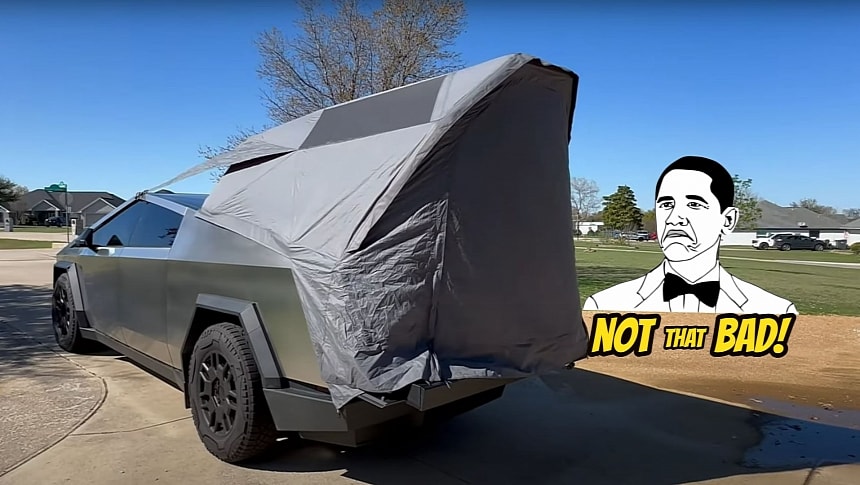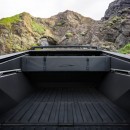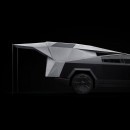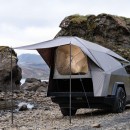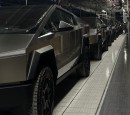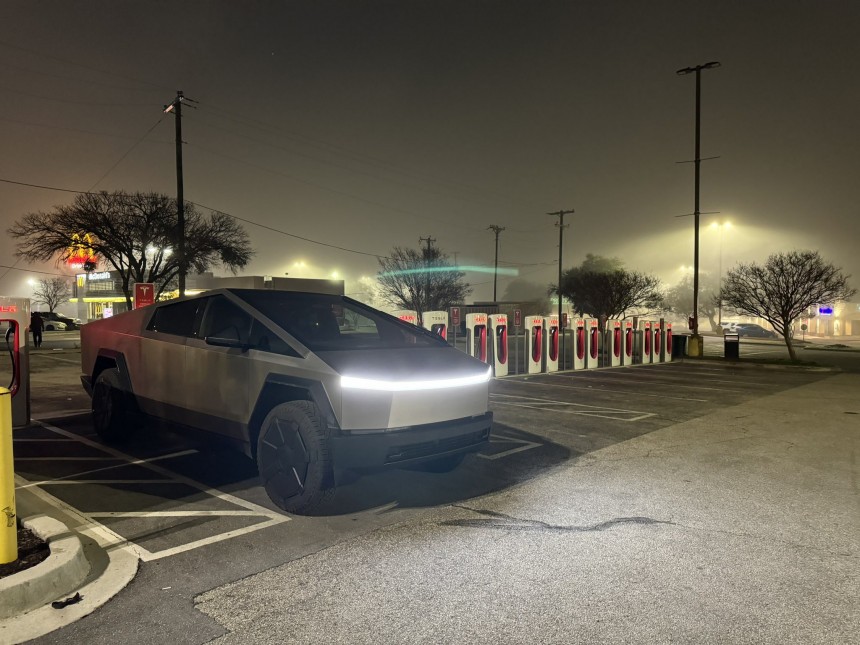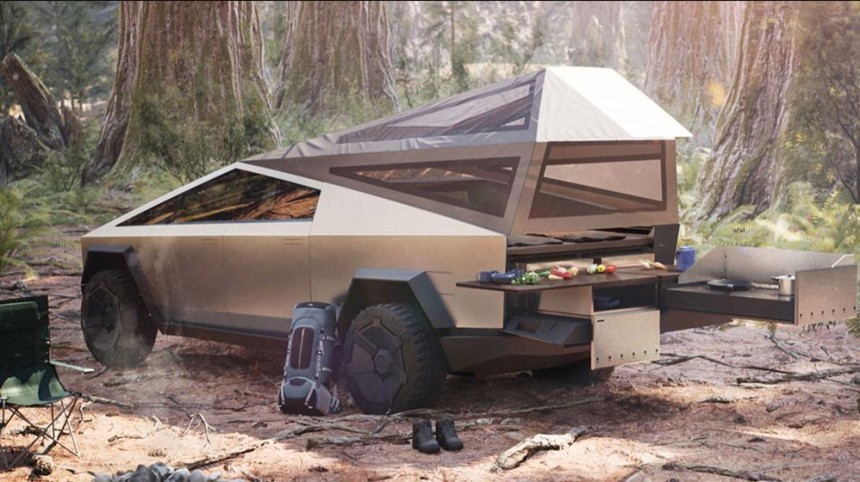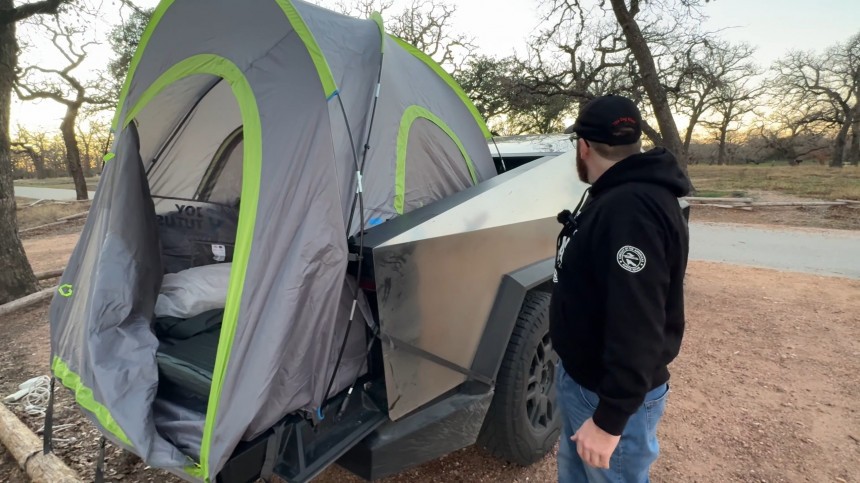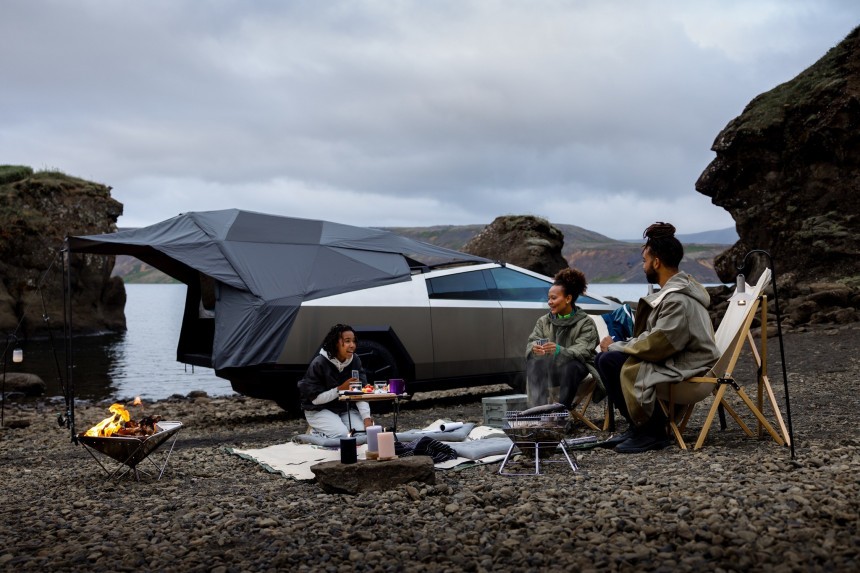Tesla started delivering the $3,000 Basecamp tent that covers the Cybertruck's bed and transforms that space into a temporary living and sleeping area for people who can do without proper accommodation. As expected, it didn't take long for some to start complaining about it. A couple of people even called it a "disappointment" or said that it feels like a "rushed and overpriced" product. But is it? Let's dive in.
People often forget that Tesla is the main reason all-electric vehicles are a thing now. This startup dared to dream and had a team that poured their hearts out to make the "zero-emission" car not only real but mainstream. Then, early adopters stepped in. Their referrals helped the brand find more buyers with minimum spending. Who needs dealerships and advertising, right?
However, Tesla is now the world's most valuable automaker. It's also the marque that gave us the world's best-selling car in 2023 – the Model Y.
On top of all that, Tesla is also the disruptor that understood early that fast charging will matter a lot. The Supercharger network now ranks supreme in North America, and it'll help Tesla earn more money after it (effortlessly) convinced everyone to switch to the North American Charging Standard (NACS).
Understandably, customers and investors now want more from the EV maker. They want the build quality to improve, the dependability to get better, the materials to be nicer, the tech to be more trustworthy and less overhyped, the range figures to be as close as possible to real life, and the prices to stop fluctuating so much.
The angular Cybertruck is the perfect example. It emerged five years ago as a brave proposition that was completely unexpected. Everyone knew EVs had to be aerodynamically efficient to consume less energy (i.e., the blobby Mercedes-Benz EQS SUV).
But there was Tesla with its weird all-electric pickup truck that was supposed to become the vehicle of choice for those wanting to survive a zombie apocalypse. The CEO himself said he wanted the Cybertruck to be stronger than a tank.
The EV became a sensation. Almost two million people got in line to have a chance at speccing one at some point. It even featured a futuristic pop-up tent that looked like a mini-greenhouse. Then, other designers followed suit with their own implementations.
Americans love driving. Many also love exploring their vast country with their vehicles. So, a Tesla pickup truck had to be versatile from the get-go. That's why it debuted with bidirectional charging, a feature the brand had opposed for quite some time, mainly because it sold Powerwalls. It also came with drive-by-wire (no physical connection between the steering wheel and the wheels), 48V architecture for the low-voltage electronics, and an 800V battery architecture.
However, in true Tesla fashion, the Cybertruck arrived with a couple of issues. Ok, a few, not just a couple!
The biggest disappointments were the range and the charging curve. The batteries didn't perform well enough, and an extra pack of (pricey) cells was needed to achieve the initial promised go capacity. When writing, that $16,000 battery extender is nowhere to be found.
But Tesla at least started to deliver the Basecamp tent. Unfortunately, it didn't take long before people started laughing about the design. In a way, they were right. The production-ready version of the tent looked nothing like the concept.
But since when are we expecting concepts to be put into production in those futuristic shapes? Very few things end up looking like the blueprint created solely to show off some ideas that might end up seeing the production line at some point. After all, cars like the Acura NSX or the BMW i8 wouldn't have been as special if they didn't look like concepts that escaped their makers' engineering centers.
Besides that, Tesla never promised a tent with glass windows. It showed what could be done, but safely storing all those panels in the bed would have been a nightmare. Moreover, attendees got to see the Basecamp tent in person at the delivery event. They never saw the concept! It was the same tent! Afterward, some showrooms also displayed a Cybertruck equipped with it. Customers knew very well what they were spending money on before pressing "Buy."
There was never any expectation of seeing a high-tech, heavy, and potentially ultra-delicate implementation. We were never going to get a Cybercamper so early. The vehicle itself still feels like a prototype. Why would an accessory be amazing and perfect?
But it's unfair and a stretch to consider this a Tesla failure. It's just another product the company launched to give owners something they can use for overlanding or prolonged off-roading sessions.
A customer received their Basecamp tent and showed in the video available below that it should take around 15 minutes to unpack everything and install it on the truck. That's acceptable! The tent has many storage pockets, enough room for two adults, a few openings to let the light in or vent, pathways for charging cables, and is made of a material that ensures breathability without compromising thermal comfort. If you're done having fun, then putting it all back should take around seven or eight minutes.
I don't know about you, but I wouldn't call this product a flop or the outcome of a Tesla-like overpromise and underdeliver strategy. It's a pricey tent, but it isn't bad. And I am willing to bet you real money that it will increase the resale value of the Cybertruck.
In the end, try to ignore what detractors have to say. Elon Musk may be eccentric, but Tesla comprises thousands of people who try their best every single day. Let's just hope that C-suite decisions will be better going forward.
However, Tesla is now the world's most valuable automaker. It's also the marque that gave us the world's best-selling car in 2023 – the Model Y.
On top of all that, Tesla is also the disruptor that understood early that fast charging will matter a lot. The Supercharger network now ranks supreme in North America, and it'll help Tesla earn more money after it (effortlessly) convinced everyone to switch to the North American Charging Standard (NACS).
Understandably, customers and investors now want more from the EV maker. They want the build quality to improve, the dependability to get better, the materials to be nicer, the tech to be more trustworthy and less overhyped, the range figures to be as close as possible to real life, and the prices to stop fluctuating so much.
Keep on keeping on
But Tesla can't and won't stop here just because some customers are upset or because some investors are complaining on Twitter (X) about Elon Musk being an outspoken billionaire.The angular Cybertruck is the perfect example. It emerged five years ago as a brave proposition that was completely unexpected. Everyone knew EVs had to be aerodynamically efficient to consume less energy (i.e., the blobby Mercedes-Benz EQS SUV).
But there was Tesla with its weird all-electric pickup truck that was supposed to become the vehicle of choice for those wanting to survive a zombie apocalypse. The CEO himself said he wanted the Cybertruck to be stronger than a tank.
The EV became a sensation. Almost two million people got in line to have a chance at speccing one at some point. It even featured a futuristic pop-up tent that looked like a mini-greenhouse. Then, other designers followed suit with their own implementations.
However, in true Tesla fashion, the Cybertruck arrived with a couple of issues. Ok, a few, not just a couple!
Not the halo electric pickup truck we needed, but the one we… Deserved?
We could call them teething challenges because it's a brand-new vehicle, but it's not wild to expect more from such an important automaker with an almost global presence.The biggest disappointments were the range and the charging curve. The batteries didn't perform well enough, and an extra pack of (pricey) cells was needed to achieve the initial promised go capacity. When writing, that $16,000 battery extender is nowhere to be found.
But Tesla at least started to deliver the Basecamp tent. Unfortunately, it didn't take long before people started laughing about the design. In a way, they were right. The production-ready version of the tent looked nothing like the concept.
Besides that, Tesla never promised a tent with glass windows. It showed what could be done, but safely storing all those panels in the bed would have been a nightmare. Moreover, attendees got to see the Basecamp tent in person at the delivery event. They never saw the concept! It was the same tent! Afterward, some showrooms also displayed a Cybertruck equipped with it. Customers knew very well what they were spending money on before pressing "Buy."
There was never any expectation of seeing a high-tech, heavy, and potentially ultra-delicate implementation. We were never going to get a Cybercamper so early. The vehicle itself still feels like a prototype. Why would an accessory be amazing and perfect?
Not great, not terrible
Still, that didn't stop some media outlets and Tesla detractors from poking fun at the $3,000 product. They weren't entirely wrong, though. This is a $3,000 tent. It's rather pricey for what it is.A customer received their Basecamp tent and showed in the video available below that it should take around 15 minutes to unpack everything and install it on the truck. That's acceptable! The tent has many storage pockets, enough room for two adults, a few openings to let the light in or vent, pathways for charging cables, and is made of a material that ensures breathability without compromising thermal comfort. If you're done having fun, then putting it all back should take around seven or eight minutes.
I don't know about you, but I wouldn't call this product a flop or the outcome of a Tesla-like overpromise and underdeliver strategy. It's a pricey tent, but it isn't bad. And I am willing to bet you real money that it will increase the resale value of the Cybertruck.
In the end, try to ignore what detractors have to say. Elon Musk may be eccentric, but Tesla comprises thousands of people who try their best every single day. Let's just hope that C-suite decisions will be better going forward.
Tesla is showcasing Cybertruck Basecamp at the Tulsa Showroom in Oklahoma. Go check it out if you’re nearby! pic.twitter.com/ZXI8nGEN0l
— Nic Cruz Patane (@niccruzpatane) March 6, 2024
Enough FUD. It’s exactly what was shown at the Cybertruck Delivery event. Here’s a video I took of it. pic.twitter.com/H7dVrjw2v4
— Austin Cooper (@AustinCooper90) March 8, 2024
